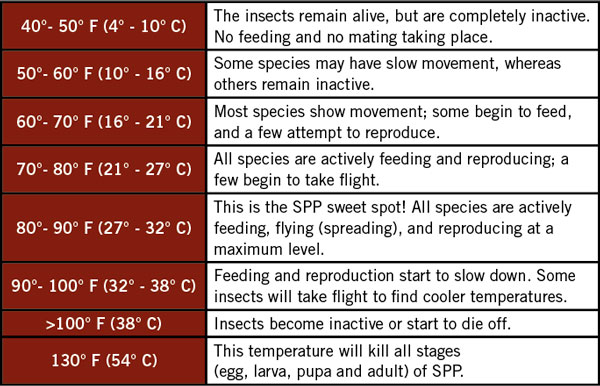
Patrick Kelley, BCE
Temperature plays an extremely important role when it comes to stored product pests (SPP) that infest cereals, grains, seeds, nuts and dry processed foods in kitchens, restaurants, warehouses and food processing plants. If SPP such as flour beetles, IMM, Mediterranean flour moths, saw-toothed grain beetles, warehouse beetles, rice weevils, etc., are present in dried food goods, we see certain biological trends of these pesty insects regarding temperature (see chart).
Monitoring for pest activity, as part of an advanced IPM program, should begin when temperatures reach 60 degrees Fahrenheit (16 degrees Celsius). The benefit of starting at this temperature is that it alerts PMPs to the insect’s first activity, and it allows PMPs to locate and remove the issue before it causes customer complaints or extensive damage to the food.
If pheromone monitoring doesn’t begin until after temperatures are above 70 degrees Fahrenheit (21 degrees Celsius), the SPP have already begun to rapidly accelerate their populations and potentially spread to other areas. Once these insects reach their “sweet spot” in terms of temperature, PMPs may never be able to get them under control unless they incorporate an expensive, wide-scale fumigation.
In the long run, keeping temperature in mind when designing an IPM monitoring program will greatly benefit PMPs and clients alike.

The post Temperature and stored product pests first appeared on Pest Management Professional.
from Pest Management Professional https://www.mypmp.net/2023/10/11/temperature-and-stored-product-pests/
Sacramento CA
No comments:
Post a Comment